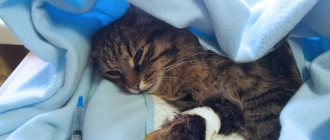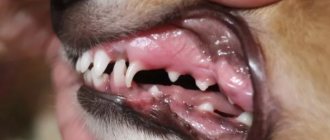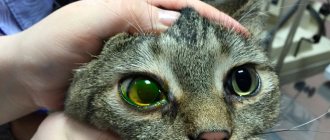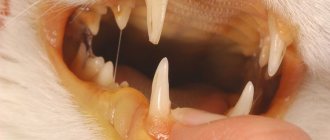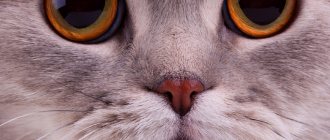Why kidneys are a weak point in cats
Scientists explain this for two reasons:
- Natural predisposition. Domestic cats have an ancestor - the African desert cat. She went without water for a long time, a feature she passed on to her descendants. They drink little and not regularly. The water balance is disrupted, which affects the functioning of the kidneys.
- Anatomical features. The cat's urethra is long, thin, and has three constrictions. In these places, urine is retained and not drained. This is a load on the kidneys.
Sick cat
Liver amyloidosis in cats - etiology and pathogenesis
It is currently believed that this is an independent, genetically determined disease that can manifest itself with varying degrees of severity or not manifest itself at all. Liver amyloidosis in cats is often provoked by lupus, chronic coccidioidomycosis and blastomycosis, bacterial inflammatory heart disease, cancer, and long-term steroid therapy.
With amyloidosis, amyloid, fibers of a waxy substance of a protein nature, is deposited in the liver. The degeneration of liver cells caused by it, disruption of its structure and nutrition leads to increased levels of liver enzymes, coagulopathy, liver failure, and intoxication with damage to other organs.
Rapidly deposited amyloid can rupture the liver, resulting in massive hemorrhage into the abdominal cavity. The body's struggle with liver dysfunction leads to overload of the spleen and especially the kidneys, which results in a wide range of pathologies of the urinary system and blood circulation. The development of hepatic cysts and hyperthyroidism is possible.
Among domestic animals, liver amyloidosis is the most common in cats. The disease is more common in cats than in cats. It is more acute in young and old than in mature animals.
Clinics and consequences
Deposits on organs cause them to cease to perform their function. With severe symptoms in the last stages of the disease, the prognosis is unfavorable and only through supportive medications can the pet’s life be extended.
Death occurs due to acute organ failure and severe intoxication of the body. There are cases of death from severe blood loss due to liver rupture and painful shock.
The animal’s body can be in a stable state for a long time, and signs will begin to appear only at the last stage, when nothing can be done.
What are the symptoms of amyloidosis in cats? Amyloid deposits in the kidney cause the organ to cease to perform its main physiological function associated with the formation of urine. Amyloid can also be deposited in the liver, spleen and pancreas, which also causes severe consequences for the entire body.
The accumulation of amyloid in the kidneys leads to the rapid development of renal failure. Symptoms of kidney failure include anorexia, lethargy, and rapid weight loss. Other clinical signs include polyuria and polydipsia, that is, excessive thirst and sharply increased volumes of urination. In some cases, episodes of spontaneous vomiting are recorded.
Renal amyloidosis in cats leads to the fact that the affected organ begins to release primary urine into the external environment, which is almost similar in composition to blood plasma. Simply put, along with secretions, a lot of valuable substances and protein leave the body.
It is very dangerous that these include globulins that prevent blood clotting. Because of this, cats with amyloidosis are extremely susceptible to thrombosis of the veins and arteries. Most often, blood clots in this disease block the pulmonary arteries, and symptoms can range from severe shortness of breath to severe distress.
How does liver amyloidosis manifest in cats? In general, as in the case of the kidney, the main function of the organ suffers. As a result, liver failure develops with all the ensuing consequences.
The main symptoms in this case are:
- Yellowness of all visible mucous membranes and skin.
- Digestive problems, expressed in alternating diarrhea and constipation, pale stool.
- The condition of the skin and coat deteriorates. The wool becomes rough and brittle.
- The animal is lethargic, apathetic, the appetite is greatly reduced or absent altogether.
We suggest you familiarize yourself with Scabies in cats: causes, prevention and treatment.
Causes of kidney disease
There are a large number of kidney diseases in cats, each of which leads to serious changes in the body. This type of disease is often diagnosed in cats and one of the most dangerous is kidney failure. This type of pathology most often causes death.
The functional features of the kidneys include specific filtration, which allows the blood entering them to be purified from harmful substances. Filtered substances that are toxic and unnecessary for the body are released along with urine.
In addition, the kidneys play an important role in water and electrolyte balance, maintaining the blood pH at the proper level, producing important hormonal substances that allow the qualitative regulation of calcium metabolism and the production of red blood cells.
By delving a little into the anatomical features, you can understand the structure and causes of the development of kidney diseases. Resembling beans, the kidneys are a paired organ consisting of a large number of nephrons - filtering units containing tubules and glomeruli.
Statistics from veterinary medicine indicate that cats are more likely to suffer from pathologies of the kidney structures than other domestic animals - dogs. The main connection is historical origin. African cats, the ancient ancestors of today's domesticated pets, have always had a need for water.
In addition, the structure of the urinary and reproductive system in cats is of great importance - in cats, the urethral canal is too long and has a characteristic narrowing at the outlet. This anatomical feature provokes frequent blockages of the urethra, causing stagnation of urine and stress on the renal structures.
We suggest you read: Kidney diseases in cats: symptoms and treatment
It has been proven that all kinds of nephritis, inflammation of the bladder, and urolithiasis always have a connection with each other, causing problems with the kidneys. The owner of the animal must know what reasons may become fundamental for the development of renal pathologies.
In the vast majority of clinical cases, diagnosed kidney problems are caused by a violation of the rules of diet. Cats eating low-quality dry food, consisting of synthetic components with a large amount of tumor-producing substances, leads to serious pathological conditions.
Toxic and carcinogenic substances accumulate not only in the kidney structures, but also in other vital organs, damaging cells and tissues, causing the death of the animal.
Kidney failure occurs against the background of a significant number of pathogenic factors - malignant neoplasms, trauma and intoxication, as well as viral and bacterial infections.
Other factors that serve as a kind of springboard for the development of pathology can also provoke disturbances in the body. These are also age-related characteristics of cats - the older the pet, the greater the likelihood of developing kidney disease.
You need to especially carefully monitor the health of the animal after 10 years. The risk of pathologies of the renal system at this age increases twice.
Among the factors is the quality of the environment. Any stress factor, intoxication with toxic substances (lead, paints, disinfectants), as well as medications, can cause irreparable harm to the body of a pet.
The main thing is age. After 7 years of life, all individuals suffer from kidney problems.
Causes:
- improper nutrition - there is either no protein in the diet at all, or an excess;
- drinking water in the region is hard, saturated with salts;
- the cat was castrated early;
- genetic predisposition;
- infections, poisoning;
- injuries;
- congenital anomaly.
Important! All individuals over 7 years of age are at risk for kidney diseases. They are shown to the veterinarian annually, undergo tests, and undergo clinical kidney examinations.
What is amyloidosis?
When cellular proteins form into folded sheets, amyloidosis occurs instead of their correct three-dimensional shape. This abnormal protein cannot be dissolved (insoluble) and is resistant to normal absorption and breakdown. When deposited in various tissues/organs in the body, it is called amyloid; it causes damage and displacement of normal cells. Minor, asymptomatic amyloid deposits may occur with age. But extensive amyloidosis can cause significant and sometimes fatal illness.
Diagnosis of kidney problems in cats
In the early, compensated stages of the disease, diagnosis is rare and extremely difficult. In addition, the signs of amyloidosis mirror those of many other diseases. A blood test can reveal anemia, increased levels of bilirubin and liver enzymes, proteinuria, and traces of bile acids. With further development, x-rays may show an enlarged liver and fluid in the abdominal cavity.
When a cat gets sick, they take him to the veterinarian. He prescribes clinical tests: they take blood and urine for analysis, measure temperature and blood pressure. Animals undergo ultrasound and tomography. In difficult cases, to clarify the diagnosis, they resort to surgery and do a urine culture.
We suggest you read: Kidney diseases in cats
It is not always possible to accurately determine the diagnosis using tests. They look at the ratio of creatinine in both blood and urine. The method is considered reliable.
Diagnosis
- A general and biochemical blood test is required. These tests do not directly detect amyloidosis, but they do provide insight into the condition of many internal organs (especially the liver). In addition, with liver degeneration, anemia often develops, and this is easily detected through a general blood test. Blood chemistry results indicate very low levels of proteins in the blood. In many cases there is a significant increase in the amount of cholesterol.
- Analysis of urine. If during this test it is revealed that the urine consists mostly of a protein component, then this almost certainly indicates amyloidosis. The ratio of urine protein and creatine is very important for diagnosis. This indicator makes it possible to finally verify that the amount of protein lost by the body actually sharply exceeds normal levels.
- X-ray. Depending on the severity of amyloidosis, the size of the organ on an x-ray may vary significantly. In any case, the size of the kidney will differ markedly from the norm, which may also provide grounds for making the correct diagnosis. But what to do if you still have doubts (at an early stage of the disease)?
- Kidney biopsy. The process is quite painful, and therefore carried out under general anesthesia (but the value of the information received is worth it). Microscopic examination of an organ sample can determine with 100% probability the presence/absence of amyloidosis even in the early stages.
Common kidney pathologies
Cats are clean animals. If they stop brushing their fur or behave apathetically, the owners go to the veterinarian. They are looking for the cause in the urinary system.
Not everyone knows where a cat’s kidneys are, but the cause of the disease often lies in them. The most common diseases of this organ are caused by bacteria and associated inflammation. These are all types of cystitis and nephritis.
The kidneys constantly filter the blood from toxic substances, so their pathologies develop.
The most common problem is kidney failure. There are two types:
- Chronic. They are provoked by poor care: hypothermia, or the cat is kept in a room that is too hot. Metabolic disorders and diabetes mellitus also lead to misfortune. The organ is destroyed, the disease is not completely cured.
- Spicy. Spontaneous inflammation with rapid development. More dangerous than chronic - the organ may fail. Causes: stress, heart disease, blood pressure, ICD.
Nephrosclerosis
There is protein and blood in the urine. Frequent urination, urine volume decreased. A biochemical blood test and kidney ultrasound are performed. It is determined: the connective tissue has grown, the organ is poorly supplied with blood. In this case, the kidneys shrink and do not perform their functions.
Treatment: diuretics, laxatives, heart medications, antibiotics.
Provide proper nutrition: 4-5 times a day, reduce salt and proteins.
Hydronephrosis
Hydrocele of the kidneys occurs when the urinary tract becomes narrowed. The kidneys become full and stretched. Subsequently, functional tissues die.
Causes: trauma, inflammation. New growths may appear in the abdominal cavity and compress the bladder.
An ultrasound examination is performed.
Important! This disease can only be cured by surgery.
Pyelonephritis
The animal is hunched over on the tray, there are bloody and purulent spots in the urine - the cat’s kidneys hurt, the symptoms are the same.
Bacteria infect the upper urinary tract, and purulent inflammation develops in the pelvis.
Chronic nephritis and diabetes mellitus lead to pyelonephritis.
Other factors:
- hypothermia;
- renal failure;
- difficult childbirth;
- poisoning
When an organ begins to fail, antibiotics and antimicrobial drugs are prescribed.
Rare disease. Protein metabolism disorder. The protein settles on the internal organs, they stop functioning.
We suggest you read: Polycystic disease in cats - symptoms and treatment
Anything that reduces immunity causes amyloidosis of the liver and kidneys. The protein is deposited in the kidneys, causing chronic renal failure.
Signs:
- weight loss;
- swelling of the paws and muzzle;
- thirst;
- dark urine;
- dyspnea.
Important! Amyloidosis of the liver and kidneys is an incurable disease.
Polycystic
Hereditary disease. Characterized by the formation of cysts with fluid. Location: outside the kidneys and on the upper urinary tract.
Examination by a veterinarian
Symptoms:
- the cat does not allow you to palpate the kidney area;
- drinks a lot, eats little;
- loses weight, gets tired;
- mucous membranes turn pale;
- frequent urination with blood;
- mouth ulcers;
- blood pressure increases;
- the fur is dull, vision is reduced.
The animal is given a blood transfusion, symptomatic treatment is given, and blood pressure is maintained.
Nephritis
Inflammation of the kidneys of an infectious or allergic nature. Nephritis occurs after a viral attack, poisoning, or after worms. The disease is also caused by hypothermia and urolithiasis.
Nephritis is indicated by:
- frequent trips to the litter box, resulting in less urine;
- diarrhea, apathy;
- jaundice;
- swelling of the eyelids and paws.
Cats are fed in moderation. Cut back on salt. They give foods containing potassium, calcium and carbohydrates.
For reference: if the owner reacts in time, the disease is easily treatable, and the cat remains healthy for many years.
Glomerulonephritis
The reasons have not been identified. There is blood and protein in the urine. More likely, an allergic reaction to low-quality food. The paws and submandibular space swell.
Provoke the disease:
- swimming in cold water;
- keeping in a damp room;
- great physical activity.
The kitty is put on a salt-free diet, bloodletting is done, and glucose is injected subcutaneously.
Signs that your cat has amyloidosis
Remember that amyloid deposits can occur anywhere in the body - sometimes locally, in just one place, and sometimes more systemically. In small quantities, no damage occurs and no disease is evident. Only when deposits interfere with normal organ function do clinical symptoms appear, and then they are associated with failure of the specific organ system affected:
- Liver diseases with liver amyloidosis;
- Kidney disease with renal amyloidosis.
Treatment of kidney diseases
When symptoms indicate kidney disease in cats, treatment is prescribed.
Treatment of a cat in the clinic
The following activities are carried out:
- eliminate the underlying and concomitant diseases;
- use medications (subcutaneously, intravenously);
- give a course of antibiotics when there are infections;
- use fluid therapy when dehydration is observed;
- use physiotherapeutic methods;
- follow nutritional rules;
- They are treated with traditional methods, herbal infusions (mint, lemon balm, St. John's wort, oregano).
Therapeutic techniques
What is the treatment for amyloidosis in dogs? Everything is not very good here. In the initial stages, Colchicine is excellent, which, if used in a timely manner, can greatly slow down or even stop the development of the disease. Anti-inflammatory drugs are also used, and intravenous infusions of drugs that help relieve intoxication are prescribed. In short, symptomatic therapy is intensively used.
The dog is prescribed a diet with minimal protein content for life. If an animal has been diagnosed with some kind of inflammatory disease, which, at least theoretically, could lead to amyloidosis, it must be treated without fail.
